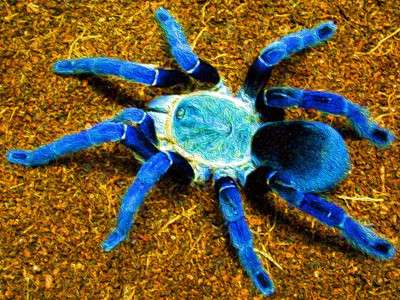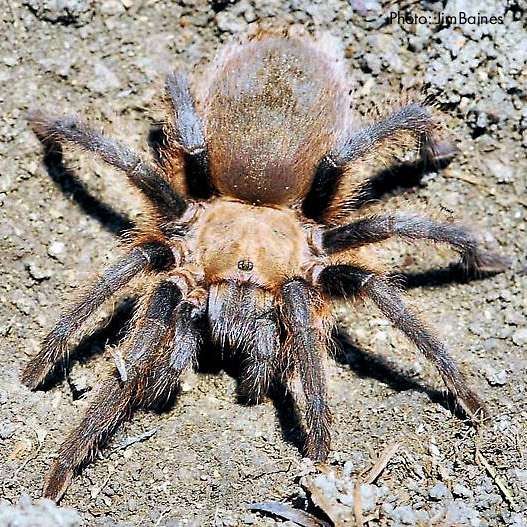
A species of spider from the Theraphosidae family (tarantulas) called Brachypelma smithi is indigenous to Mexico. Both have been referred to as Mexican redknee tarantulas and have been mixed up with Brachypelma hamorii. Among those who keep tarantulas as pets, Mexican redknee tarantulas are very common. B. smithi do not differentiate between the two species or tie it to B. hamorii. The Mexican state of Guerrero’s Pacific coast is the natural habitat of the terrestrial tarantula B. smithi.
Geographical Location
Brachypelma smithi, the Mexican red-knee tarantula, is mostly found in Mexico’s central Pacific coast.
Habitat
Mexican red-knee tarantulas typically live in scrubland, deserts, arid thorn woods, or tropical deciduous forests, which are dry environments with little to no vegetation. They reside in tunnels at the base of cacti and other thorny plants in rocky locations. The entrance to a burrow is typically a little bigger than the tarantula itself. Although it is typically covered or coated with the local substrate, a web carpet spreads from the burrow out of the aperture. Silk can be found close to the entrance of the burrow when it is in use. Extra silk is found in the burrows of adult females during the breeding season.
Feeding Habits
Mexican red-knee tarantulas eat mice, frogs, and huge invertebrates. Mexican red-knee tarantulas wait in their lair for potential food to cross their web in order to ambush them. Each leg’s palps, which are sensitive to vibrations, taste, and smell, are used to find prey. Mexican red-knee tarantulas quickly emerge from the burrow to bite their prey after spotting them. They use their front legs to hold down their prey while injecting their venom to paralyze and liquefy their prey. In addition to consuming their prey’s liquids, they also leave behind undigested body parts. These are often carried to another part of the burrow while being wrapped in a web.
Description of the body
- Mexican red-knee tarantulas are big, dark spiders with lengths between 12.7 and 14 cm.
- They have brown hairs covering their black abdomen.
- Their name comes from the orange to dark red-orange joints on their legs.
- They have a characteristic black square on their creamy beige carapace.
- Four pairs of legs, two pedipalps, and hollow fanged chelicerae attached to venom glands make up the cephalothorax.
- With their front two legs, they grip and catch prey while walking with their other four legs. On the backside of their abdomen, there are two sets of spinnerets.
- Male adults have unique copulatory organs that are situated on their pedipalps. Males and females are often larger.

Lifespan
Male Mexican red-knee tarantulas rarely survive longer than 10 years, although females often live 25 to 30 years.
Importance for Humans
Positive
Mexican red-knee tarantulas are well-liked and highly profitable as pets since they are calm and colorful. They are also housed in numerous zoological facilities. Hollywood movies frequently use Mexican red-knee tarantulas as well.
Negative
The majority of Mexican red-knee tarantulas are calm and won’t bite people. However, they have the ability to discharge urticating’s hairs as a kind of protection, which can be irritating. Even though they are deadly, their bites can be as painful as a bee or wasp sting. Some people respond to spider venom more severely because they are allergic to it.
Keeping as Pet
Housing
Keep your tarantula in an aquarium made of glass or plastic with a tight lid and ventilation. Generally speaking, the tank should be around two to three times wider and as tall as the spider’s leg span. It should ideally have a side opening. This will stop the spider from tumbling every time you need to clean the tank because tarantulas prefer to hang upside down at the top of the tank.
Care for Mexican red-knee tarantulas must include maintaining a constant temperature and humidity level. The temperature of the terrarium should be kept between 75 and 80 degrees Fahrenheit, which can be accomplished by placing a heat mat under a section of the tank. While additional heating is advised for the majority of North American terrarium conditions, it’s also crucial to provide your spider with a cold, unheated space in case the tank becomes overheated.
Maintain a humidity of 60 to 70 percent, which can typically be accomplished via evaporation from a bowl of water. However, spraying the tank could be required in some dryer households.
Exercise
Like any other animal, the Mexican red-knee tarantula needs exercise to maintain a healthy body. This spider doesn’t require a lot of exercise, though. It should be able to obtain all the activity it needs if you give it a big enough tank.
Grooming
In essence, tarantulas “groom” themselves through molting. As long as their surroundings stays at the proper temperature and humidity and live prey is kept away from them until their new exoskeleton has set, they normally won’t need your assistance.
Table





